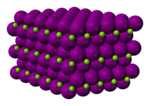Magnesium iodide
| |||
| |||
| Names | |||
|---|---|---|---|
| IUPAC name
Magnesium iodide
| |||
| Identifiers | |||
| |||
3D model (JSmol)
|
|||
| ChemSpider | |||
| ECHA InfoCard | 100.030.738 | ||
| EC Number |
| ||
PubChem CID
|
|||
| UNII |
| ||
CompTox Dashboard (EPA)
|
|||
| |||
| |||
| Properties | |||
| MgI2 (anhydrous) MgI2.6H2O (hexahydrate) MgI2.8H2O (octahydrate)[1] | |||
| Molar mass | 278.1139 g/mol (anhydrous) 386.2005 g/mol (hexahydrate) 422.236 g/mol (octahydrate) | ||
| Appearance | white crystalline solid | ||
| Odor | odorless | ||
| Density | 4.43 g/cm3 (anhydrous solid) 2.353 g/cm3 (hexahydrate solid) 2.098 g/cm3 (octahydrate solid) | ||
| Melting point | 637 °C (1,179 °F; 910 K) (anhydrous, decomposes) 41 °C (octahydrate, decomposes) | ||
| 54.7 g/100 cm3 (anhydrous, 0 °C) 148 g/100 cm3 (anhydrous, 18 °C)[2] 81 g/100 cm3 (octahydrate, 20 °C) | |||
| Solubility | soluble in ether, alcohol and ammonia | ||
| −111.0·10−6 cm3/mol | |||
| Structure | |||
| Hexagonal (anhydrous) Monoclinic (hexahydrate) Orthorhombic (octahydrate) | |||
| Thermochemistry | |||
Heat capacity (C)
|
74 J/mol K | ||
Std molar
entropy (S |
134 J/mol K | ||
Std enthalpy of
formation (ΔfH⦵298) |
-364 kJ/mol | ||
| Hazards | |||
| GHS labelling: | |||

| |||
Signal word
|
Warning | ||
| H315, H319 | |||
| NFPA 704 (fire diamond) | 
3
1
1 COR | ||
| Related compounds | |||
Other anions
|
Magnesium fluoride Magnesium bromide Magnesium chloride | ||
Other cations
|
beryllium iodide calcium iodide strontium iodide barium iodide | ||
Except where otherwise noted, data are given for materials in their standard state (at 25 °C [77 °F], 100 kPa). | |||
| Infobox references | |||
Magnesium iodide is the name for the chemical compounds with the formulas MgI2 and its various hydrates MgI2(H2O)x. These salts are typical ionic halides, being highly soluble in water.
Uses[]
Magnesium iodide has few commercial uses, but can be used to prepare compounds for organic synthesis.
Preparation[]
Magnesium iodide can be prepared from magnesium oxide, magnesium hydroxide, and magnesium carbonate by treatment with hydroiodic acid:[3]
Reactions[]
Magnesium iodide is stable at high heat under a hydrogen atmosphere, but decomposes in air at normal temperatures, turning brown from the release of elemental iodine. When heated in air, it decomposes completely to magnesium oxide.[4]
Another method to prepare MgI2 is mixing powdered elemental iodine and magnesium metal. In order to obtain anhydrous MgI2, the reaction should be conducted in a strictly anhydrous atmosphere; dry-diethyl ether can be used as a solvent.
Usage of magnesium iodide in the Baylis-Hillman reaction tends to give (Z)-vinyl compounds.[5]
References[]
- ^ Perry, Dale L.; Phillips, Sidney L. (1995), Handbook of Inorganic Compounds, CRC Press, p. 240, ISBN 0-8493-8671-3, retrieved 2007-12-09
- ^ Magnesium Iodide MSDS at AlfaAesar[permanent dead link]
- ^ Patnaik, Pradyot (2003), Handbook of Inorganic Chemicals, McGraw-Hill Professional, pp. 527–528, ISBN 0-07-049439-8, retrieved 2007-12-09
- ^ Wilsmore, N. T. M. (1891). "Note on Magnesium Iodide". In James Hector (ed.). Report of the Third Meeting of the Australasian Association for the Advancement of Science. Sydney: The Association. p. 116. Retrieved 2007-12-09.
- ^ Tietze, Lutz-Friedjan; Brasche, Gordon; Gericke, Kersten (2006), "Domino Reactions in Organic Synthesis", Chemical Reviews, Wiley-VCH, 96 (1): 115–136, doi:10.1021/cr950027e, ISBN 3-527-29060-5, PMID 11848746, retrieved 2007-12-09
- Iodides
- Magnesium compounds
- Alkaline earth metal halides
- Deliquescent substances



